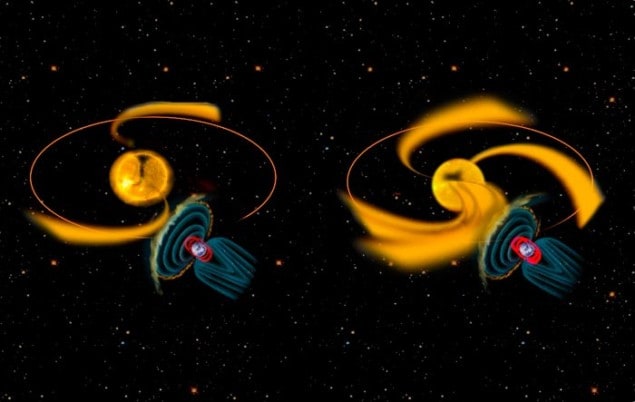
Researchers in the US may have discovered further evidence that the Sun is heading towards an extended period of quiet activity, the like of which has not been seen since the 17th century. The impact this may have on climate is poorly understood but it would be good news for satellite communications, which would continue to avoid the harsher impacts of space weather.
Scientists have long known that the Sun’s magnetic activity varies over a cycle of approximately 11 years. Greater magnetic activity leads to more “sunspots”, or darker patches visible on the solar surface. These sunspots are regions where the magnetic field lines have become twisted due to differential rotation in the outer layers of the Sun.
Particularly violent sunspots can result in the sudden release of magnetic energy in the form of solar flares, which cause the outpouring of protons and electrons into space. Some of these particles can reach the Van Allen radiation belt of Earth – the outer region of Earth’s own magnetic field – where they are accelerated to speeds approaching the speed of light. During the solar maxima, when sunspot numbers are at their peak, the abundance of particles shooting around in the radiation belt can become a real hazard to the satellites that reside there.
Extended calm
We were expecting to reach the next solar maxima around 2011–2012. However, space weather experts have been surprised over the past few years to report very few signs that the number of sunspots has been picking up since the last solar minimum in 2006. This has prompted some space scientists to forecast that we are heading towards another prolonged spell of quiet sunspot activity, the last of which was observed between 1645 and 1715 in a period called the “Maunder Minimum”.
In this latest research, Sarah Gibson at the National Center for Atmospheric Research (NCAR) in Colorado and her colleagues focused on another process by which the Sun discharges energy. They looked at the lower-energy streams of plasma that carry protons and electrons towards the Earth at a steadier rate than the storms associated with sunspots. Scientists had previously thought that these streams largely disappeared during periods of quiet sunspot activity.
The researchers found that the Sun’s effect on the Van Allen radiation belt was three times greater in 2008 than the effect recorded in 1996 during the previous solar minimum. The result comes as a surprise given that the current solar minimum has fewer sunspots than any minimum of the past 75 years.
Strength a sign of weakness
Gibson told physicsworld.com that it could be the current “weakness of the Sun” that could account for the strengthened solar streams. This is because during solar maxima, when sunspots appear in abundance, the strong solar magnetic field acts to contain the solar streams. However, when sunspot activity is very quiet, this is a sign that the field is significantly weakened and this can allow stronger solar streams to escape through “coronal holes”. “The solar wind can hit Earth like a fire hose even when there are virtually no sunspots,” she said.
The particularly strong solar streams of 2008 could, according to Gibson, be another sign that the Sun is in an unusually weak state at the moment. The study also raises questions about how the streams may have affected Earth in the past when the Sun went through extended periods of low sunspot activity.
Steven Schwartz, a space and atmospheric physicist at Imperial College in London agrees that space weather and climate models could benefit from an improved understanding of the Sun’s magnetic activity and its impact on Earth. “This research shows that while we know a lot about the Sun and its impact on the Earth, there are still important elements we don’t really understand yet,” he said.
In terms of day-to-day threats to satellites from space weather, these latest findings could be good news for satellite communication companies that feared that they may have “had it too good” in recent years. As the space weather conditions for satellites were assumed to be glorious, there had been little assurance that the technology could still function properly as conditions get harsher when we move towards the next solar maximum. “This technology managed to pull through the peak in this solar stream, which is now subsiding, so it should be okay as solar flare activity increases,” said Doug Biesecker, a space weather scientist at the National Oceanic and Atmospheric Administration.



